By Michelle Gellis AP LAc MAc DiplAc
Introduction.
Fascia is a thin casing of connective tissue that surrounds and holds our organs nerves, bones, blood vessels
and muscles in place. It provides internal structure and has nerves that make it almost as sensitive as our skin. Fascia plays an important role in the structure, appearance, and function of our face. Due to the unique relationship between our facial skin and facial muscles, healthy movement of facial fascia is imperative to the nervous, muscular, and circulatory functions of our face. Chinese medicine is uniquely

suited to treat the fascial layers of the face to improve both appearance and function.
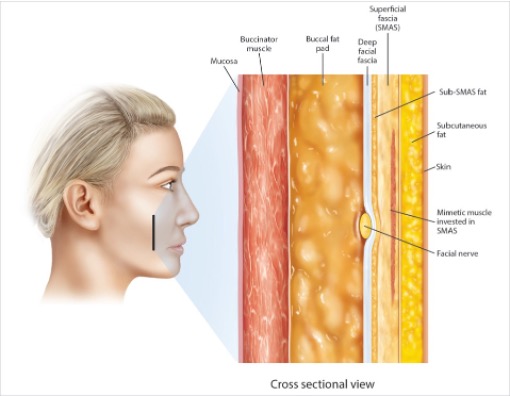
Facial Fascia.
There are two layers of fascia on the face. Superficial facial is the layer of connective tissue right under the skin on the face. It acts as the support and infrastructure for your skin and is responsible for giving it lift and tone. It can also carry tension and adhesions that restrict circulation of blood and lymph. Deep fascia is a tougher, more dense connective tissue which connects your skin to the muscle and fat below and forms a “girdle” of facial muscles known as the SMAS (superficial musculoaponeurotic system). Deep fascia includes temporalis fascia, parotid–masseteric fascia, investing fascia of the neck, periosteum, and orbital septum.1
The superficial facial fascia invests the superficially situated memetic muscles (platysma, orbicularis oculi, and zygomaticus major and minor). The deep facial fascia represents a continuation of the deep cervical fascia into the face. This is important because the branches of the facial nerve within the cheek lie deep to this deep fascial layer. If the facial nerve becomes entrapped, facial movement can become limited and pain can result.2
There are two relationships which exist between the superficial and deep facial fascia. In some areas of the face these fascial planes are separated by an areolar plane (connective tissue) and other regions of the face the superficial and deep fascia are connected to one another through a series of dense fibrous attachments.
Fascial Adhesions.
Fascial adhesions, also known as scar tissue adhesions (or fibrous adhesions, or more simply adhesions),
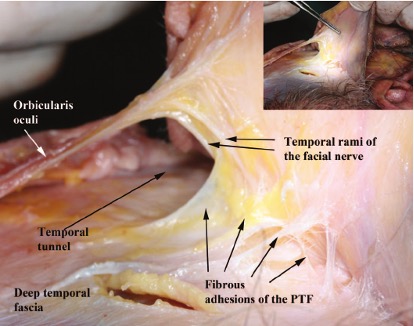
are composed of fibrous fascia collagen fibers. These collagen fibers are the same substance that makes up tendons, ligaments, and other fibrous fascial tissues. Nerve and vascular structures that come through the SMAS layer can become entrapped through fascial adhesions causing pain, lack of movement, lymphatic system restriction and inflammation.
Fascial adhesions can occur from trauma, surgical procedures, repetitive facial movements, inflammation, facial fillers, injections, scars, other facial procedures.
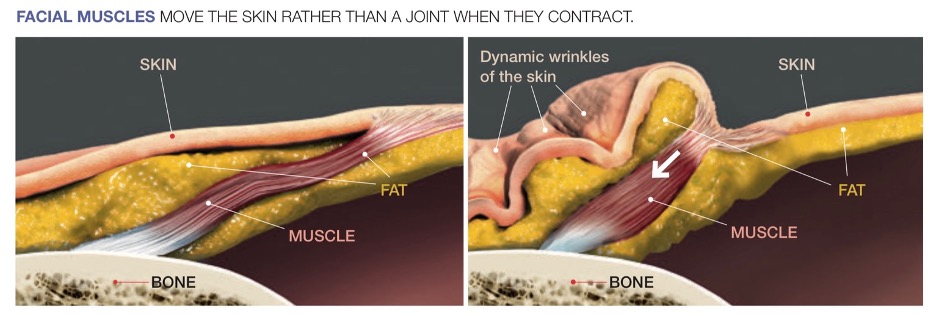
Over time these adhesions can lead to changes in facial appearance such as skin wrinkles and sagging. This can result from the fascia growing out and lengthening. Since the skin on the face is attached to fascia, it begins to fall with it. Conversely, if the fascia is restrictive and stiff it will hold deeper facial wrinkles “in place” until released. As seen in the photo below, the skin of the face is uniquely connected to the facial muscles so when a muscle contracts the skin moves with it. Therefore, we can move the skin on our face without having to move a joint. Apart from cosmetic concerns, fascial adhesions can restrict movement in the face resulting in limited facial expressions, pain, and in some instances, paralysis.
The areas where these types of wrinkles are most apparent are on the forehead, around the eyes and the lips. Sagging can occur along the jaw line, under the chin, on the neck itself and in the eyelid area.
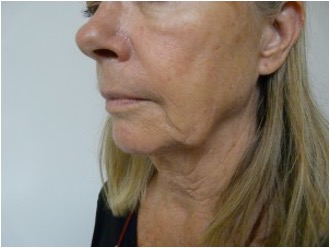

There are several treatment modalities that we can use to effectively release fascial adhesions. The three I will discuss in this article are: facial cupping, facial Gua Sha, and sub muscular needling. These three modalities can be used together or separately to effectively break up fascial adhesions and increase movement and function, as well as restore a youthful appearance to the skin.
Facial cupping.
Facial cupping is uniquely suited for treating fascial adhesions on the face. Small glass
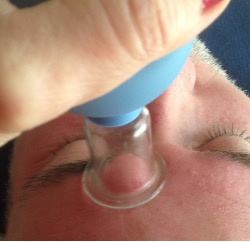
cups such as the ones pictured can be used with a non-reactive oil such as Argan oil, almond oil, or coconut oil. The cups are not left in place as they would be if you were doing cupping on
someone’s back, rather they are moved across the muscles of the face to increase blood flow to the area, break up fascial adhesions, reduce inflammation and increase lymphatic drainage. I recommend that anyone interested in performing facial cupping gets specialized training as there are contraindications and precautions and specific methods required to achieve the desired effect without causing further inflammation or leaving marks on the face and neck.
Facial Gua Sha.
Facial Gua Sha is another method of breaking up facial fascia which works very well

on bony areas such as the jaw, forehead and along the clavicle and skull. Facial Gua Sha tools can be used in a circular motion on the temporalis and scraped across the gallea aponeurotica and along the jaw to help with issues like TMJ. On the forehead wrinkles can form from certain facial expressions and the gua sha tools can be moved back-and-forth vigorously to help to break up the deep wrinkles. As with facial cupping, facial Gua Sha should not be practiced without training. There are contraindications and precautions especially with individuals who have had any sort of surgery or injury.
Submuscular needling.
Sub muscular needling is a technique of inserting needles through and underneath the muscles of the face at a deep level. By needling through the fascial tissue, you can effectively break up the facial fascia and increase the movement in the area. There are several muscles of the face that lend themselves very well to sub muscular
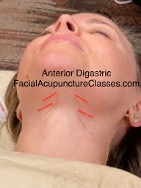
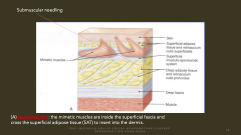
needling. These are the frontalis, the corrugator the masseter the temporalis the digastric, corrugator, digastric and masseter. In the photo you can see how the needle being placed through the fascia could help in breaking up fascial adhesions.
Conclusion
The fascial layers of the face are an important consideration when treating cosmetic and neuromuscular concerns of the face. Fascial adhesions can limit the function and effect the appearance of the face. They be treated effectively with acupuncture, cupping and Gua Sha.
1 https://pubmed.ncbi.nlm.nih.gov/30085556/
2https://journals.lww.com/plasreconsurg/Abstract/1992/03000/The_Relationship_of_the_Superficial_and_Deep.7.aspx
3 https://anatomy4sculptors.com/product/anatomy-of-facial-expression-paperback/?gclid=Cj0KCQjwqc6aBhC4ARIsAN06NmMsfMtAMwyjrUT_Jl0OEG1Dzr6JDFzo1VivEAcOqT2eUs0DB1XFLBoaApIeEALw_wcB
